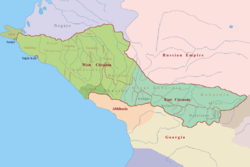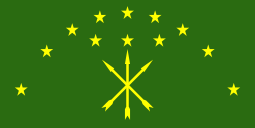Circassians in Iran
| Total population | |
|---|---|
| Precise population unknown due to heavy assimilation and lack of censuses based on ethnicity.[1][2][3] Second largest Caucasus-derived group in the nation.[2] | |
| Regions with significant populations | |
| Tehran, Gilan Province, Mazandaran Province, Rasht, East Azerbaijan Province, Fars Province,[4] Isfahan, Aspas | |
| Languages | |
| Mainly Persian, as well as Circassian in small amounts | |
| Religion | |
| Muslim |
The Circassians in Iran (East Circassian and West Circassian: Адыгэхэр Къажэрей, Adyghexer Kŭazhéreĭ; Persian: چرکس در ایران) are an ethnic minority in Iran. Circassians in Iran differ somewhat from other Circassians in diaspora in that most in the former stem from the Safavid and Qajar era, although a number migrated as muhajirs in the late 19th century as well. The Circassians in Iran were very influential during periods in the last few centuries. The vast majority of them have assimilated to Persian language, and no sizeable number speaks their native Circassian languages anymore.[1] Once a very large minority in Iran, nowadays due to being heavily assimilated over the course of time and the lack of censuses based on ethnicity, population estimates vary significantly. They are, after the Georgians, the largest Caucasus-derived group in the nation.
In Persian, the word Cherkes (چرکس) is sometimes applied generally to Caucasian peoples living beyond Derbent in Dagestan,[4] which was the northernmost principal city of Iran prior to its ceding to Russia in the first half of the 19th century following the Treaty of Gulistan.
History
Circassians in Iran have a long history. To a certain good extent, they shared the same role as their brethren who lived in neighbouring Ottoman Turkey; many were importees, deportees, slaves, but also made up many of the notable noble families in the empire, while many others were kingmakers, military commanders, soldiers, craftsmen, peasants, while they also composed many of the kings' wives and women in the harem. Under the various kings of the Safavid and Qajar dynasty, hundreds of thousands of Circassians would eventually happen to live in Iran.
Safavids
The first Circassian presence in Iran is noted since the early era of the Safavids, during which Shaykh Junayd raided various regions of Circassia and carried of prisoners back.[5] From the time of shah Tahmasp I, the Circassians started to play an important role in Iranian society,[5] and to appear as a large ethnic group in the successive empires based in Iran.
In order to make a counterbalance to the tribal, ethnic, and favoured interests the Qizilbash gave which make a system imbalanced, Tahmasp had already started to make the first steps of creating a new layer in Iranian society.[6] The kings before Tahmasp and he himself often found themselves incapable of effectively ruling due to the extremely strong influence the Qizilbash expressed in all spheres of the empire. After all, they had formed the backbone of the Safawiyya from the earliest days, as well as having provided substantial military power since the same time, on which the Safavids would rely for nearly their entire existence, though in changing degrees. In order to break this system, a counterbalance was needed, and a new layer in society was the medium through which this could be reached.[6] This system and policy of creating a new layer in society (also called the "third force", as they were a new ethnic class alongside the Turks and Persians in the empire), was started and initiated by Tahmasp I, and would be fully and only composed of hundreds of thousands of Christian and pagan Caucasian, mostly Circassian and Georgian, deportees, importees, slaves, and migrants, and this new society layer was to be eventually fully accomplished and implemented by Shah Abbas I.[7] Out of this new layer, a new military force was established as well that would directly contest the hegemony of the Qizilbash everywhere in the empire, and replace them from all their positions. These "gholams", or military slaves, were part of this newly created layer in society, and were, although initiated by Tahmasp I, only perfectioned, completed, and implemented by Abbas I, and were thus also solely composed of tens of thousands of ethnic Christian or pagan Circassians, Georgians, and to a lesser extent Armenians as well as other peoples of the Caucasus. Thus, being gathered from Iran's northern territories and beyond, this military slave corps would be created in order to systematically nullify the Qizilbash's influence on the empire and to secure the kings from their grip over the kingdom. Eventually, the large amounts of Circassians and other Caucasians, only loyal to the shah, would vy through the system with the Qizilbash for political hegemany and supremacy, and be victorious,[4] although sometimes they would vy against each other as well.[8]
Circassians made up a good bulk of these elite armies (the so-called ḡolāms), and played therefore a pivotal role. This elite [slave system] army was very similar to the Janissaries of neighbouring Ottoman Turkey, in its implementation and formation.[9] The ones in the armies received, after advanced education, conversion to Islam, and upbringing by Muslim families, the best military training and equipment, and were the strongest force and class of the empire. Other massive amounts of Circassians were, like the Georgians, employed and deployed in all other possible aspects and positions that the empires offered, such as the harem, civil administration, military administration, peasantry, and craftry, amongst others, while other large numbers were initially settled in various regions in mainland Iran, including Gilan, Mazandaran, and Fars.
In Thomas Herbert's Travels in Persia: 1627–1629, he writes that in Aspas some 40,000 transplanted Christian Circassians and Georgians were living, as he was travelling through various regions of the Safavid Empire.[10] By the time of king Suleiman I's reign (r. 1666–1694), an estimated 20,000 Circassians, Dagestanis, and Georgians were living in the Safavid capital of Isfahan alone.[11]
Many of the shahs, princes, and princesses descended from noble Circassian lines. Many of the Safavid nobility at the court were Circassian.[12] In fact, the Safavids their heavily mixed ancestry includes several Circassian lines.[13][14] Shah Abbas II and Shah Suleiman I are just some of the examples amongst the highest nobility that were born by Circassian mothers.
Qajars
Following the mass expulsion of the native Circassians of the Northwest Caucasus in 1864 mainly towards the Ottoman Empire, some also fled to neighboring Qajar Iran, which bordered the Ottoman Empire and Imperial Russia. In Iran, the government followed an assimilation policy, starting the gradual absorption of the Caucasian refugees into the population. Some of these deportees from after 1864 rose to various high ranks such as in the Persian Cossack Brigade, where every member of the army was either Circassian or any other type of ethnos from the Caucasus.[15]
Modern day
Despite heavy assimilation over the centuries, Circassian settlements have lasted into the 20th century.[4] However, the Circassian languages once also widely used by the large Circassian minority, no sizable number of Circassians in Iran speak the language anymore.[2][16][17][18] After the Georgians, the Circassians are the second largest Caucasus derived group in Iran, comprising significant numbers.[2]
Notables
Notable Iranians of either partial or full Circassian descent include:
- Fawzia Fuad, Empress consort of Iran (1941–1948)
- Princess Shahnaz of Iran
- Princess Zahra Mahnaz Zahedi
- Prince Keykhosrow Jahanbani
- Princess Fawzia Jahanbani
- Teresia Sampsonia
- Pari Khan Khanum
- Safi of Persia
- Abbas II of Persia
- Suleiman I of Persia
- Farhad Beg Cherkes
- Shamkhal Sultan
- Nakihat Khanum
- Yusuf Agha
- Moḥammad-Bāqer Ṣafī Mīrzā
- Ūzūn Behbūd Beg
- Qazāq Khan Cherkes, governor of Shirvan, commander of the Qizilbash (Karamanlu and Ḵeneslū divisions)[4]
- Anna Khanum
- Najafqoli Khan Cherkes
- Fereydun Khan Cherkes
- Sultan-Agha Khanum
- Suleiman Mirza
See also
- Ethnicities in Iran
- Circassians in Turkey
- Circassians in Iraq
- Circassians in Syria
- Peoples of the Caucasus in Iran
References
- 1 2 "International Circassian Association". Retrieved 28 April 2014.
- 1 2 3 4 Encyclopedia of the Peoples of Africa and the Middle East Facts On File, Incorporated ISBN 978-1438126760 p 141
- ↑ Fredrik Thordarson, “Caucasus ii. Language contact. Caucasian languages in Iran,” EIr. V, 1990, pp. 94-95.
- 1 2 3 4 5 "ČARKAS". Retrieved 26 April 2015.
- 1 2 Eskandar Beg, I, pp. 17–18
- 1 2 "Tahmāsp I". Retrieved 12 May 2015.
- ↑ "BARDA and BARDA-DĀRI v. Military slavery in Islamic Iran". Retrieved 26 April 2015.
- ↑ Babaie, Sussan (2004). "Slaves of the Shah: New Elites of Safavid Iran." pp. 17, I.B.Tauris, ISBN 1860647219
- ↑ "BARDA and BARDA-DĀRI v. Military slavery in Islamic Iran". Retrieved 25 April 2015.
- ↑ Thomas Herbert. Travels in Persia: 1627–1629 Routledge, 10 October 2005 ISBN 1134285841 p 117
- ↑ Matthee 2012, p. 67.
- ↑ Aptin Khanbaghi. The Fire, the Star and the Cross: Minority Religions in Medieval and Early Modern Iran I.B.Tauris, 22 February 2006 ISBN 0857712667 pp. 130–131
- ↑ Safavid Iran: Rebirth of a Persian Empire, L.B. Tauris. 2006, p. 41.
- ↑ Rudolph (Rudi) Matthee Encyclopaedia Iranica, Columbia University, New York 2001, p. 493
- ↑ "The Iranian Armed Forces in Politics, Revolution and War: Part One". Retrieved 23 May 2014.
- ↑ Oberling, Pierre (7 February 2012). "Georgia viii: Georgian communities in Persia". Encyclopaedia Iranica. Retrieved 9 June 2014.
- ↑ "Circassian". Official Circassian Association. Retrieved 9 June 2014.
- ↑ Chardin, Sir John (June 1997). "Persians: Kind, hospitable, tolerant flattering cheats?". The Iranian. Archived from the original on 20 June 1997. Retrieved 9 June 2014. Excerpted from:
- Chardin, Sir John (1988). "Book 2, Chapter XI: Of the Temper, Manners, and Customs of the Persians: A XVII th. Century Viewpoint". Travels in Persia, 1673–1677. New York: Dover Publications. pp. 183–197. ISBN 9780486256368. OCLC 798310290. Retrieved 9 June 2014.
Sources
- Manz, Beatrice; Haneda, Masashi (1990). "ČARKAS". Encyclopaedia Iranica, Vol. IV, Fasc. 7. pp. 816–819.
- Matthee, Rudi (2012). Persia in Crisis: Safavid Decline and the Fall of Isfahan. I.B.Tauris. ISBN 978-1845117450.
- Savory, Roger, Iran Under the Safavids; Cambridge University Press, 2007 ISBN 0521042518.
- P. Oberling, "Georgians and Circassians in Iran," Studia Caucasica (The Hague) 1, 1963
- J. R. Perry, "Forced Migrations in Iran During the Seventeenth and Eighteenth Centuries," Iranian Studies 8, 1975, pp. 199–215.
- N. Falsafī, Zendagānī-e Šāh ʿAbbās-e awwal, 4 vols., Tehran, 1334-46 Š./1955-67
- Babaie, Sussan, Slaves of the Shah: New Elites of Safavid Iran I.B.Tauris, 15 October 2004 ISBN 1860647219

